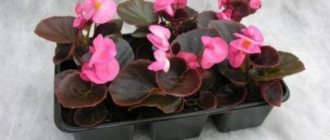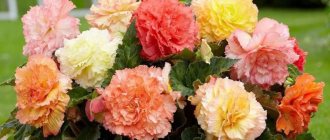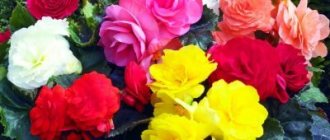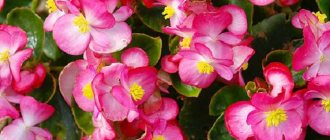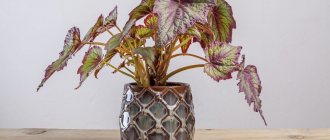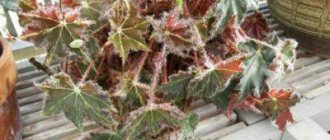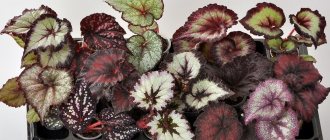Begonia: Description and origin
Begonia was first introduced to Santo Domingo in 1690 by botanist Charles Plumiero. It was described by C. Linnaeus and named the genus in honor of Governor Michel Begon. The plant belongs to the genus Begoniaceae.
The plant has an erect stem, lodging, herbaceous and succulent, on which the nodes are strongly pronounced. The number of internodes reaches 10-12 and corresponds to the number of leaves. The root system is well branched; some species produce tubers.
The inflorescence is a complex panicle with constantly growing lateral inflorescences. In the axil of each leaf of the main shoot, starting from the fifth or sixth, an inflorescence is formed, consisting of three to five male and female flowers.
Important!!!
The apical (terminal) flower is always male.
Begonia flowers are heterosexual, irregular in shape (zygomorphic), with a brightly colored perianth. The male flower consists of four round and elongated oval petals, two sepals and two membranous, slightly colored round-oval bracts. The female one has four to five petals, a calyx of three free sepals and two bracts.
Begonia
Tuberous begonia has large flowers (5-15 cm), while evergreen begonia has small flowers (2-3 cm). The lower ovary is three-locular, the pistil is equipped with three pairs of fused and helically twisted stigma blades, the surface of which is covered with thin needle-shaped papillae. The fruit is a three-lobed winged capsule, cracking along the side seams.
The seeds are very small, orange-yellow, with cells on the surface. Despite their small size, mature seeds have a differentiated straight embryo without endosperm.
On a note!!!
In ornamental gardening, evergreen begonia (B. semperflorens Link et Otto) and tuberous begonia (B. x tuberhybrida Voss) are usually used. Recently, seeds of more and more new varieties of begonias have been appearing in flower shops.
The quality and appearance of plants depend on proper agricultural technology and the nature of the soil. In favorable conditions, begonia grows well, blooms profusely and is practically not damaged by diseases and pests. Therefore, before growing it, you need to choose a place to plant it, create the right substrate and take care of proper watering.
Reproduction at home
In order to breed tuberous begonia, three main methods are used:
Tuber division
The division of the bulb is carried out with the onset of spring, when buds appear on it. Using a sharp knife, it should be cut so that there are growth points on each part. The cut areas must be treated using charcoal or brilliant green for this purpose. You need to plant it in a pot, covering only half of the part with soil. As soon as the roots appear, the remaining part should also be covered with soil, without affecting the buds.
Whole tubers can be stored for no more than five years. Before planting them in the ground, they must be cleaned of traces of rot and mold.
Cuttings
This procedure is carried out in spring.
To do this, you will need shoots whose length does not exceed 10 cm. Peat or a container filled with water is suitable for rooting. If you decide to plant them in the ground, then do not forget to cover the cuttings with film, which will prevent the soil from drying out. After a few weeks, the cuttings will begin to produce roots and grow. This means it's time to plant them in separate pots.
Planting from seeds
In order for your plants to go to seed, you need to have female and male flowers so they can be pollinated.
It is necessary to sow the seeds in December or January, which will allow the plant to bloom in the same summer. Leafy soil is best for growing seeds. Do not bury the seeds in soil under any circumstances, since for germination it is enough to simply sprinkle them on the surface of the soil, after which, using a spray bottle, you need to slightly moisten the soil. Using the film, you need to create a kind of greenhouse, which must be opened periodically, allowing air to penetrate inside. Don't let the soil dry out, keep it moist. If the air temperature is constantly around 25 degrees, then in a few weeks the first shoots will appear. If you do everything correctly and do not allow the soil to dry out completely, then all the seeds will definitely germinate. Slightly grown sprouts need to be planted and covered with film for a few more days. When the 5th leaf appears on the sprout, it must be sprayed with a growth regulator. This allows the begonia to take a beautiful shape and delight its owners with its lush and unusual flowering. About five months after planting, the flower will begin to produce buds.
The first two methods, unlike the last, allow the young plant to be the same as the flower from which it originated.
Begonia: temperature
The origin of begonia from tropical areas left an imprint on its heat-loving nature. It does not tolerate negative temperatures and is not winter-hardy. The need for heat manifests itself already at the first stage of its development. The optimal temperature for swelling and germination of seeds is 20-22° C. Young plants (seedlings) are especially sensitive to changes in heat.
Begonia Cleopatra
The most favorable air temperature for the plant is 16-18 ° C. Subsequent development of begonia proceeds better at a temperature of 22-24 ° C. Increasing the temperature to 25 ° C enhances the growth of the vegetative parts of the plant, regardless of the length of the day.
For the successful development of the horse system, a temperature of 18-20° C is needed. A decrease to 8-10° C leads to a slowdown in root growth. Causes withering of the crop and death of the flower. Temperatures above 25° C disrupt the vital processes of begonias.
Important!!!
If the bushes have already formed, then they are able to tolerate a drop in air temperature to 5-7 ° C, but even slight frosts can destroy the above-ground part of the begonia.
Tuberous begonias develop better at moderate temperatures and slightly increased air humidity. They are planted at a distance of 20-25 cm, deepening the tubers by 1.5-2 cm. They respond well to fertilizing during flowering.
How to grow at home without problems
If you decide to grow begonia at home, then you must not forget that this plant does not like to be in close quarters, and also prefers to grow in the same place without the slightest rearrangement.
Many novice gardeners encounter some problems when growing a plant, and this is easy to understand by its condition.
- If all the foliage is covered with small spots, this means that the begonia has received sunburn. To make the stains go away, you need to move the flower to a place where the shadow will prevail.
- If you moved the begonia, but you couldn’t get rid of the stains, then this shows that it lacks nutrients or water. But there are also cases when these spots appear from excess moisture.
- Drying of the leaves and their subsequent falling off indicates that the plant does not have enough moisture in the air. The most common time of year for this problem to occur is spring. During this period, the heating has not yet been turned off, which leads to severe dry air. Regular humidification of the room will help save the plant.
- Excessive watering causes the stem to rot, and in order to prevent the begonia from dying, it is necessary to reduce watering. Don't forget to remove all affected flowers and shoots from the bush.
Begonia: lighting
In the first phases of development, it is better to grow begonia in diffused light, since direct sunlight burns the leaves and kills small plants. In the phase of three or four true leaves, begonia needs sufficient lighting. Budding and flowering occur better in open rather than shaded areas.
Begonia photo
Begonia is a short-day plant. An increase in night temperature during a short day accelerates the formation of flowers, and during a long day it slows it down.
In conditions of a 10-16 hour day at an air temperature of +15 ° C, active formation of flowers occurs. With a short day, under the influence of sunlight, the plants bloom faster, but the growth of shoots in tuberous begonia stops, and the tuber increases in size.
FAQ
In the process of growing begonias, unusual situations may arise, and gardeners have additional questions about how to deal with them.
Why doesn't my indoor begonia bloom?
The most common reasons for the lack of flowering of begonias:
- the plant does not have enough light;
- low level of indoor air humidity;
- the temperature regime is violated;
- excessive amounts of fertilizer;
- using hard water for irrigation;
- non-compliance with the rest period;
- drafts.
It is necessary to change the conditions for caring for the plant and continue to monitor it. It may be necessary to transplant the begonia into fresh substrate. Lack of flowering may also indicate that it is time to rejuvenate the flower.
Why do begonia buds fall off immediately after they appear?
This phenomenon indicates a weakened state of the flower. It can be caused by improper watering and lack of nutrients. Begonia needs feeding.
Why do begonia leaves turn yellow?
The yellowing of leaves is caused by sufficient moisture and nutrients. This may also be a sign that the soil is infested with parasites that are damaging the begonia's root system. Such soil should be replaced, and the roots should be treated with a weak solution of potassium permanganate before replanting.
Begonia: watering
Wild begonia species grow in tropical areas with high air humidity, but they do not tolerate excessively damp soils.
Begonia watering
Similar requirements apply to growing begonia at home. Excess moisture is especially dangerous when growing seedlings, as young plants can die from root rot (blackleg).
Important!!
Begonia should not be watered with cold water at a temperature below 12° C. Because this causes the roots to die and the entire plant may die.
When grown in open ground, begonia needs abundant watering. If the summer is humid, with little temperature fluctuation and large amounts of precipitation, then there is no need for watering. It is very important that the plant receives the required amount of moisture during budding.
Important!!!
The optimal soil moisture for begonia is 80%, and air moisture 60-70%. Such conditions have a positive effect on the abundance and duration of flowering.
If the flowering time coincides with a hot and dry period of summer and the plant lacks moisture, then the buds and flowers will fall off, and the leaves will lose their decorative effect, so the begonia should be watered more abundantly.
On a note!!!
To maintain the required moisture, the soil is mulched with peat, humus or sawdust.
Mulching delays water evaporation, protects against weeds and enriches the soil with humus. To preserve tubers in winter, the soil must be almost dry, since waterlogging leads to rotting or premature germination of the buds.
Spotted begonia - Begonia maculata
Homeland - tropics America, Asia, Africa. Family Begoniaceae.
Begonia spotted is a species that includes subspecies with leaves of different shapes. Some are round, others are oblong, curled like a shell or obliquely heart-shaped. The leaves always contain either a pattern in the form of variegated multi-colored spots, or brightly contrasting patterns.
Begonia spotted inflorescences are produced in a loose cluster with flowers on a drooping peduncle. If you do not want the leaves to become smaller due to flowering, which takes a lot of energy from the plant, then you can tear off the buds, this way you can preserve all the beauty of Begonia. Features of care. Location – loves a bright, but not sunny place. Avoid sudden changes in lighting. In summer, place it a little further from the window, and in winter, on the contrary, closer to the glass. One can say about Begonia that it is almost a greenhouse plant; it is not taken outside even in summer.
Temperature – for Begonia should also be stable 19-24 °C, and in winter 16 °C. In winter, to avoid hypothermia of the roots, the pot is placed on polystyrene foam and insulated with synthetic padding.
Watering - in the warm season, regular and plentiful, without waterlogging the soil. When watering, keep the leaves away from water to avoid the appearance of brown spots. Winter watering is moderate. Feeding – once a month, from March to October, apply complex fertilizers for ornamental plants. Air humidity – needs high humidity, but does not tolerate spraying. In this case, you can use a humidifier. In winter, protect heating radiators from dry air. Soil and replanting - so that Begonia pleases you with its decorative leaves longer, choose a container that is not too cramped and replant it after two years.
Reproduction - Spotted begonia reproduces: by dividing the bush or by leaf. In the first case, take a strong bush with leaves of 3-5 centimeters. In the second case, either part of the cut sheet, laying it on wet sand and pressing it. Or a leaf with a cutting in water that covers the cutting by 1 centimeter, while the water is constantly changed. When leaves appear on the cuttings, they are planted in the ground.
exoticminisad.ru
Begonia: GROWING conditions, planting
For planting, it is best to take young, undivided tubers, 5-6 cm in diameter. They are round and slightly depressed at the top. Old tubers are larger, flattened with stump-like outgrowths from old stems.
Begonia planting
Before planting, remove any remaining soil from them and carefully trim off the mass of dried roots. Young tubers are sometimes slightly wrinkled, but they are quite suitable for planting.
Important!!!
To disinfect and restore turgor, they are immersed for one hour in a solution of potassium permanganate (0.05%) at room temperature.
Growing usually begins in mid-March. They bloom in about 3 months. If there are a lot of tubers, it is advisable to plant them in boxes. The substrate is peat with the addition of chalk or fluff lime at the rate of 50-70 g per bucket of peat.
Planting of tubers occurs in the following sequence:
- the boxes are half filled with peat;
- lay out the tubers at a distance of 5-8 cm from each other;
- fill the gaps between them so that the tops protrude above the surface;
- The peat is slightly compacted and moistened with a solution of complete mineral fertilizer. (1-1.5 g per 1 l).
At first, when watering, water should not fall on the central part of the tuber.
Begonia planting
Boxes with tubers are kept in a bright place at a temperature of 18-22'C. On sunny days they provide shade by whitening the glass in greenhouses. During the growing period, 3-4 feedings are carried out. The first - 4-5 weeks after planting, the subsequent ones after 2-3.
It is advisable to alternate feeding with organic and mineral fertilizers. At the beginning of May, the boxes are taken out to warm greenhouses, shaded and provided with good ventilation. About three weeks before planting in the ground, the plants begin to harden off. Planting in the ground, balcony boxes and containers is carried out only after the end of spring frosts.
How to prepare begonia for winter
With the onset of autumn, tuberous begonia stops blooming and growing. Over time, the foliage begins to die and the shoots dry out. At this moment, the tuber begins to receive all the beneficial substances, which allows it to strengthen and grow.
As soon as cold weather sets in, dried shoots should be cut off and watering of the plant should be reduced.
If the flower grew in the garden, then with the onset of cold weather you should not immediately start digging up its tubers. Of course, as already mentioned, begonia loves warmth very much, but before digging up its bulbs you should wait until all the shoots and leaves die off and the beneficial substances pass quietly to the tubers. During this period, new growth points begin to form on them.
Young plants with small bulbs should overwinter in pots on well-lit windowsills. Under such conditions, the foliage and stems do not die off, but the growth and flowering of begonias stops. The air temperature in the room where the flower will winter should not be below +15 degrees. The plant is watered quite rarely.
Adult bulbs are stored in cool places. If the plant grew in a pot, then the bulb can be left to winter in it. If the tuber was dug out of the ground, then it should be placed in a box filled with sand or peat. Be sure to moisten the substrate in which the tubers are stored so that they do not dry out. The period in which the bulbs are dormant begins in November and lasts until February.
Begonia: harvesting tubers
The first frosts serve as a signal to harvest the tubers for storage. The above-ground part is cut down to 2-3 cm with pruning shears, dug out with a shovel or garden fork without clearing the soil from the roots, the tubers are placed in boxes and transferred to a warm, ventilated room.
After about 2 weeks, remove the remaining shoots, which by this time are easily separated. The tubers are dried and stored in the basement at a temperature of -10°C and air humidity of 80-85%. The gaps between the tubers are covered with peat and, if necessary, a second layer of tubers is laid.
Begonia: reproduction
Begonia propagation: Begonias are usually propagated by dividing tubers, cuttings and seeds.
Begonia: propagation by dividing young tubers
When dividing, young tubers are first germinated. For germination, they are laid out in a warm room on moistened peat. After the buds wake up, the tubers are cut into 2-4 parts, sprinkling the cuts with charcoal and sulfur powder.
Begonia propagation by rhizome division
Divisions with dried cuttings are grown in the same way as whole tubers, but they begin to do this 2-3 weeks earlier, since division somewhat inhibits the development of plants.
Begonia: propagation by cuttings
When propagated by cuttings, mother tubers begin to grow in January at a temperature of 20-22'C. After about a month, the cuttings are broken out by lightly pressing at the base. For summer flowering, it is enough to leave 2 sprouts on the tuber. Damaged areas are sprinkled with charcoal and sulfur powder.
Begonia leaf propagation
After light drying, the cuttings are planted in sandy-peaty soil to a depth of 2-3 cm; it is advisable to powder the sections with charcoal with the addition of growth stimulants. Boxes with cuttings are regularly moistened, shaded and kept at a temperature of 20″C.
Rooting usually occurs after 20-30 days, after which the cuttings are planted in boxes with a mixture of leaf humus, peat and sand (2:1:1 or 3:2:1) at a distance of 8 cm from each other and placed in a bright place. As they grow, young begonias are fed with organic fertilizers.
Begonia propagation by cuttings
On a note!!!
Young seedlings often do not have time to form tubers suitable for winter storage, and they are cultivated as annuals.
Valuable varieties are grown in pots, which are pinned into the ground for the summer. At the end of August, the plants are brought indoors and grown until November (the flowers are removed), then the stems are cut off, and the tubers in pots are placed in winter storage.
Begonia from seeds
The most effective method of propagation is seed. Sowing is done in late December - early January. Seedlings usually bloom by the time they are planted in the ground.
Begonia from seeds
The seeds are very small, up to 50,000 in 1 g, so they are sown without covering them in shallow bowls or boxes with a sifted mixture of:
- leaf soil;
- peat;
- sand.
Take 2 parts of leaf soil, and 1 part of tofa and sand. If the peat is acidic, then add fluff lime (50-100 g per bucket of mixture).
Ultra-small begonia seeds germinate well if snow is poured onto the substrate and the seeds are scattered over it. When it melts, it will slightly draw the seeds into the substrate, and you will have what you need.
For disinfection, the substrate is moistened with a solution of potassium permanganate (0.1%). The crops are kept under glass and before the first picking they are evenly moistened with heated water (about 30'C) from a tray. Shoots appear in 12-14 days. The glass is first raised, and after a few days it is removed completely.
They dive at the stage of 2-3 true leaves. A month later, a second pick is carried out. Two weeks after the second picking, they begin to feed with mullein once every 7-10 days with the addition of potassium nitrate (1 tablespoon per 10 liters of infusion). At the end of April - beginning of May, one specimen at a time is planted into 7-11 cm pots.
On a note!!!
Begonias at any age can tolerate transplantation without pain, but their very fragile leaves must be protected. In the future, care is the same as for plants grown from tubers.
Tuberous begonias are short-day plants. It is advisable to plant specimens that are lagging behind in development or obtained from late sowings in a separate bed and, from mid-July, completely shade them with opaque material for 3-4 weeks from about 6 to 9 p.m. This helps to increase the size of the tubers by about 1.5-2 times. It is recommended to do the same with cuttings.
On a note!!!
The ripening of tubers is also facilitated by the removal of flowers.
Begonias are used in flower beds, garden beds and as a potted plant. The popularity of these plants is explained by the abundant and colorful flowering throughout the frost-free period. They go well with many low annual flowering and decorative foliage plants.
How to plant tuberous begonia correctly
The most favorable time for planting a plant is mid-March, since at this time the plant will be able to receive a satisfactory amount of daylight for successful development and growth.
In order for the tuber to develop well, it urgently needs the maximum permissible peat content in the soil. Pay attention to the planting material itself, as it consists of two sides . One of them is slightly concave, the other is slightly rounded. The rounded side is placed in the ground.
Very often, when planting, a mistake is made and the tuber is planted on the wrong side, which means that you should not expect a positive result from such planting.
Planting and care in the garden
The flower loves areas well lit by sunlight.
But they should not be straight, as this will damage the foliage of the plant. For begonia to grow successfully, it needs diffused lighting or slightly shaded areas in the garden. A properly selected place will allow the flower not only to grow quickly, but also to bloom magnificently and for quite a long time. Begonia is a flower that is very picky about the composition of the soil in which it will grow.
So that it can please you with its abundant flowering, you need to choose a place with nutritious, loose soil that has neutral acidity.
An adult plant thrives in soil that contains:
- deciduous ground
- sand
- peat
- humus
Be sure to maintain a ratio of 3:1:1:1.
Care and cultivation at home
If you are growing a flower in an apartment or house, then the window on which it stands must be covered with film. The fact is that its leaves are harmful to direct sunlight, which can harm them.
Remove dried flowers
Begonia does not like when its usual lighting changes. In addition, the slightest changes in the position of the pot on the windowsill can lead to it dropping all its buds. The north side is not suitable for growing the plant, since in too dark areas the flower may lose its decorative effect, not release buds and stretch out the shoots. If you decide to plant begonia in a flowerbed, then choose a slightly shaded place. An area covered in shade with other plants, with a slightly dense crown, is suitable.
The container where you plan to plant the tubers should also be carefully selected. The distance from the planting material to the edge of the pot should not be more than 4 cm. The third part of the pot should be filled with drainage, which is covered with pre-prepared soil on top.
Preparing and planting tubers
The plant must be planted only at room temperature, which is approximately 20 degrees.
- Before you start planting, be sure to clear the tubers of old roots.
- Don't forget to degrease them by soaking them in a pink solution of potassium permanganate for 30 minutes.
- Make a small hole in the ground and place the bulb in it with its growing point facing up.
- Cover it with soil without disturbing the buds.
- After planting, the tubers need to be watered, but it should be taken into account that excessive watering can lead to rotting of the bulb.
- The most favorable temperature for growing begonia varies from 15 to 20 degrees.
- It will take about 2 weeks for the tubers to germinate.
- As soon as the shoots reach 5 cm, add the remaining soil, completely covering the tuber.
- In young plants, as a rule, about 2-3 growing points are left. All others must be carefully removed.
Don’t forget that begonia loves moisture and you should never let the soil dry out, as this will lead to the death of the root system.
Water at the root
Once the roots are fully formed, it is necessary to regularly water the plant with settled water. The procedure is carried out late in the evening or early in the morning.
In order to maintain the most suitable humidity, spray the air near the plant every day using a spray bottle for this purpose. Never allow water to come into contact with leaves or flowers, as this will cause them to become stained, rotten or powdery mildew.
To cool the plant in too hot summers, you need to place it in a basin filled with damp, cold stones.
Should you use fertilizers?
Capricious begonia prefers to grow in fertile soil, which will certainly lack lime.
Feeding the plant must begin at the beginning of summer and continue until the end of autumn. The procedure is usually carried out twice a week.
It is allowed to fertilize the flower with any fertilizers that are intended for indoor plants; just decide on the type: flowering or decorative foliage.
Begonia: varieties, varieties, types
The genus contains over 1,600 species, growing in tropical and subtropical regions of America, Africa and Asia. Of these, about 400 hundred species are cultivated at home.
Begonia albo – picta Bull
Homeland - Brazil. Bush perennial plant. The stem is highly branched, up to 1.0 m high. The leaves are shiny, green, ovate-sharp, with small protrusions, densely covered with white dots. Flowers with white and pink petals grow in clusters.
Begonia albo – picta Bull
Due to its decorative properties, it is widespread. Shade-tolerant. In summer, diffused light and abundant watering are needed. Grows well in warm and cool rooms. Propagated by stem cuttings after 2 years. Young plants are more decorative; with age, the lower branches become bare. They are replanted annually in an earthen mixture, like other begonias.
Begonia Bismarckii Veitch
Homeland - Jamaica. An evergreen, unpretentious indoor plant. The stems are smooth, red, juicy. The leaves are large, pointed, fleshy, up to 20 cm long, bright green above, with small grayish dots, red below. Flowers in large clusters, bright red, luxurious.
Begonia Bismarck
Propagates well from stem cuttings. Loves a bright location. Bismarck begonia is replanted annually in the spring.
Begonia heracleifolia
Homeland - Mexico. Stem - thick, short, creeping rhizome. Perennial evergreen hairy plant. Leaves are up to 18 cm in diameter, with 5-9 deep, narrow, slotted and serrated lobes, dark green, petioles 40-50 cm long, straight, flowers are white with a pink tint, small, with 2 prominent rounded parts.
Begonia heracleifolia
This decorative species has many varieties: with leaves bordered along the edges with a dark green, almost black stripe (V. var. nigricans Hook.), or with hogweed-green leaves and silvery stripes along the nerves, purple below, etc. (V. her. var. sunderbruchii hort). Propagated by rhizomes and apical stem cuttings. In summer, a semi-shaded location is required.
Welton's begonia (Begonia weltoniensis)
This bushy, beautifully flowering begonia was obtained by hybridization. A plant of medium height with succulent branched stems, thickened at the base. The leaves are small, light green, double-coarsely toothed. The stems, leaf petioles and leaf veins are red. Blooms profusely from spring to late autumn with small bright pink flowers.
Welton's begonia (Begonia weltoniensis)
In winter, some of the shoots die off. In spring, young shoots develop from the base of thickened stems. The plant is shade-tolerant. Easily propagated by cuttings.
Welton's begonia has abundant and long-lasting flowering, and the red petioles and veins of the leaves, standing out against the background of lush light greenery, give the plant a special originality. High decorative qualities and unpretentiousness allow it to be widely used in many forms of landscaping.
Begonia semperflorens
Perennial evergreen plant. Forms low (20-40 cm), lushly branched bushes with succulent, fragile stems, which in older plants become woody at the base. The leaves are medium-sized, on short petioles, juicy, bright green, shiny, slightly obliquely heart-shaped, with small teeth along the edge, each of which ends in a soft point. There are varieties with beautiful pinkish, reddish or brown-brown leaves.
Begonia semperflorens
Evergreen begonia flowers, depending on the variety, can be white, pink or red. They are located several at a time in the leaf axil. When flowers are pollinated, fruit-boxes with small seeds are formed.
The plant got its name because of its abundant flowering, which lasts from spring to autumn. The flowering period can be extended if the plant is pruned short in the spring and kept in bright windows, and if it is watered and fed abundantly in the summer.
Easily propagated by cuttings and seeds. One of the most common begonias, during its cultivation numerous varieties have been bred. Unpretentiousness, ease of propagation, and high decorative qualities allow the use of evergreen begonia when creating any interiors. Widely used in outdoor landscaping, when decorating flower beds and balconies.
Hybrid tuberous begonia (Begonia x tuberhybrida)
Tuberous begonias are represented by a huge variety of varieties obtained through hybridization. Back in 1870, gardeners managed to obtain many hybrids. Thus, the breeder Vilmorin in 1891 obtained a winter-blooming begonia from two wild species. This is Gluard de Lorraine (named after the famous artist). Modern varieties produce flowers 20-30 cm in diameter (Everest variety). In size they exceed the flowers of large chrysanthemums and peonies.
Hybrid tuberous begonia
A common feature of these plants is the presence of a tuberous-thickened rhizome. From 1 to 5 low shoots with herbaceous, translucent stems develop from the buds of the rhizome. The leaves are alternate, obliquely heart-shaped, unequal, with a pointed apex, and in some varieties covered with thin, sparse hairs. In the axils of the leaves there are peduncles, each of which bears 2-5 flowers.
Flowers, depending on the variety, can be simple, double, semi-double, fringed, curly, narcissus-like. The color of the corolla comes in a wide variety of colors and shades: white, yellow, pink, red, orange. Blooms all summer until late autumn.
In summer, tuberous begonias are kept in well-lit places, watered and sprayed abundantly. In the fall, when the plants begin to go into a dormant state, watering is reduced. After the shoots dry, the tubers are left in the same pots and watering is stopped, but the earthen ball is not allowed to dry out completely, occasionally watering from the saucer.
Tubers overwinter well in indoor conditions, especially when kept cool.
Tubers are planted, depending on the planned flowering period, from February to May in soil composed of turf, humus and leaf soil with an admixture of sand. The tubers are placed in the soil so that the upper part rises slightly above the surface of the earth. Tubers germinate slowly, so watering during this period should be very moderate. Propagated by seeds, cuttings and tubers.
Abundantly and brightly blooming tuberous begonias are a picturesque decoration of any interior. They are also widely used in outdoor landscaping for the design of flower beds, ridges, tapeworms, etc.
Begonia Elatior
The species was formed by crossing tuberous and Socotrans begonias. The difference between the hybrid is its lush and long flowering. A photo of Elatior begonia can be seen below.
Indoor begonia Elatior is demanding to care for. She needs a well-lit place. Since it blooms poorly in the shade, and the flowers become small and not very attractive.
Begonia Elatior
The temperature in the room must be stable, and the presence of drafts is unacceptable. The most optimal option is 20-25 degrees. At low readings, the plant stops blooming. Humidity is high. You cannot spray the flower from above. To increase humidity, use trays of water or devices to humidify the atmosphere.
Begonia has a weak root system, so the soil must be loose. Drainage is necessary at the bottom of the pot so that water does not stagnate at the roots. This will help prevent them from rotting.
Watering is moderate. Excess water can cause rotting of the horses and death of the plant. The water should first be left at room temperature. During the flowering period, it is recommended to water more often, but only after the soil has dried from the previous watering.
Begonia Camelia
This is a tuberous large-flowered begonia. It is a powerful plant with thick stems and large double flowers. Its height reaches 30-35 cm. It blooms all summer and autumn.
Begonia Camellia
It has a dormant period - gradually stop watering in the fall, cut off the plants for the winter, and store the tubers in a cool place until spring planting. Do not remove indoor begonia tubers from the pot.
She prefers fertile soils with a slightly acidic reaction, light or slightly shaded rooms, the temperature in which should not exceed 23°C.
It responds well to feeding with mineral and organic fertilizers. Watering is moderate.
Periodically, the air around the plants should be sprayed, but make sure that drops of water do not fall on the leaves.
Can be grown in the garden in flowerpots or at home in a pot.
Royal Begonia (Begonia Rex)
It has large, luxuriously colored leaves that are simply impossible not to notice; in addition, this plant perfectly purifies the air due to its special properties.
Royal Begonia (Begonia Rex)
Royal begonia belongs to the begoniaceae family. Almost all of its varieties have very original asymmetrical leaves with an unusual color. In nature, begonias are most often found in tropical forests and mountains. However, they survive well at home.
Indoor royal begonia has a fairly large root system, which often rises above the soil. The leaves of this plant are wide, have a heart-shaped base and pointed edges. Depending on the variety, royal begonia has different leaf colors - from gray-copper to cherry-brown with a special shine.
The flowering of the royal begonia is quite modest and even meager compared to the leaves. It is the leaves that are the main advantage of begonia.
Share your experience in growing begonias by leaving a comment on the page.
Pests and diseases
Begonia can be affected by gray rot. Often occurs in high humidity and low light indoors.
Often fungal mold and powdery mildew may appear on the leaves .
Common pests: spider mites and aphids.
Control methods and treatment
affected or diseased leaves are removed, and the pruned areas are treated with a fungicide.
of colloidal sulfur, helps against powdery mildew . With the help of insecticides they fight against aphids and spider mites.
Decorative deciduous begonia is an unpretentious plant to care for. It can bloom all year round under optimal conditions. At home, the plant restores a calm atmosphere, and is also used for medicinal purposes to treat headaches, conjunctivitis, and stomach ulcers.
Also on the pages of our website you can familiarize yourself with such varieties as Cleopatra, Bauer, Masona, Hogweed, Royal, Vorotnichkovaya, Krasnolistnaya.


